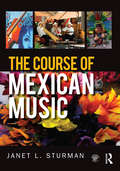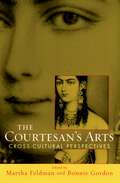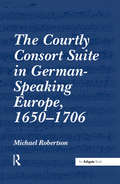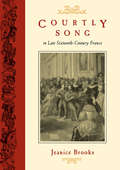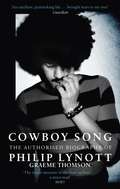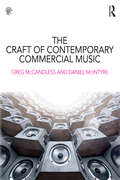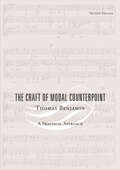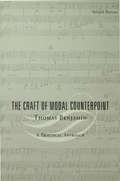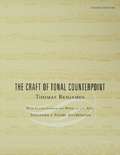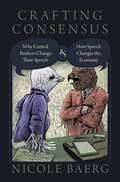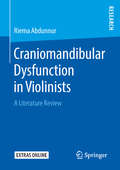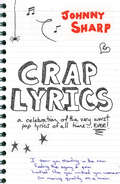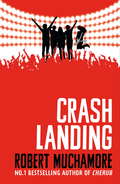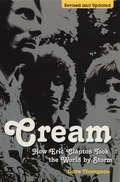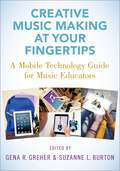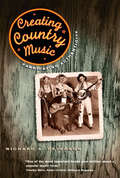- Table View
- List View
The Course of Mexican Music
by Janet SturmanThe Course of Mexican Music provides students with a cohesive introductory understanding of the scope and influence of Mexican music. The textbook highlights individual musical examples as a means of exploring the processes of selection that led to specific musical styles in different times and places, with a supporting companion website with audio and video tracks helping to reinforce readers' understanding of key concepts. The aim is for students to learn an exemplary body of music as a window for understanding Mexican music, history and culture in a manner that reveals its importance well beyond the borders of that nation.
The Course of Mexican Music
by Janet SturmanThe Course of Mexican Music provides students with a cohesive introductory understanding of the scope and influence of Mexican music. The textbook highlights individual musical examples as a means of exploring the processes of selection that led to specific musical styles in different times and places, with a supporting companion website with audio and video tracks helping to reinforce readers' understanding of key concepts. The aim is for students to learn an exemplary body of music as a window for understanding Mexican music, history and culture in a manner that reveals its importance well beyond the borders of that nation.
The Courtesan's Arts: Cross-Cultural Perspectives
by Martha Feldman Bonnie GordonCourtesans, hetaeras, tawaif-s, ji-s--these women have exchanged artistic graces, elevated conversation, and sexual favors with male patrons throughout history and around the world. Of a different world than common prostitutes, courtesans deal in artistic and intellectual pleasures in ways that are wholly interdependent with their commerce in sex. In pre-colonial India, courtesans cultivated a wide variety of artistic skills, including magic, music, and chemistry. In Ming dynasty China, courtesans communicated with their patrons through poetry and music. Yet because these cultural practices have existed primarily outside our present-day canons of art and have often occurred through oral transmission, courtesans' arts have vanished almost without trace. The Courtesan's Arts delves into this hidden legacy, unveiling the artistic practices and cultural production of courtesan cultures with a sideways glance at the partly-related geisha. Balancing theoretical and empirical research, this interdisciplinary collection is the first of its kind to explore courtesan cultures through diverse case studies--the Edo period and modern Japan, 20th-century Korea, Ming dynasty China, ancient Greece, early modern Italy, and India, past and present. Each essay puts forward new perspectives on how the arts have figured in the courtesan's survival or demise. Though performative and often flamboyant, courtesans have been enigmatic and elusive to their beholders--including scholars. They have shaped cultures through art, yet their arts, often intangible, have all but faded from view. Often courtesans have hovered in the crevices of space, time, and practice--between gifts and money, courts and cities, feminine allure and masculine power, as substitutes for wives but keepers of culture. Reproductively irrelevant, they have tended to be ambiguous figures, thriving on social distinction while operating outside official familial relations. They have symbolized desirability and sophistication yet often been reviled as decadent. The Courtesan's Arts shows that while courtesans cultures have appeared regularly in various times and places, they are universal neither as a phenomenon nor as a type. To the contrary, when they do crop up, wide variations exist. What binds together courtesans and their arts in the present-day post-industrialized world of global services and commodities is their fragility. Once vital to cultures of leisure and pleasure, courtesans are now largely forgotten, transformed into national icons or historical curiosities, or reduced to prostitution.
The Courtly Consort Suite in German-Speaking Europe, 1650-1706
by Michael RobertsonDance music at the courts of seventeenth-century Germany is a genre that is still largely unknown. Dr Michael Robertson sets out to redress the balance and study the ensemble dance suites that were played at the German courts between the end of the Thirty Years War and the early years of the eighteenth century. At many German courts during this time, it was fashionable to emulate everything that was French. As part of this process, German musicians visited Paris throughout the second half of the seventeenth century, and brought French courtly music back with them on their return. For the last two decades of the century, this meant the works of Jean-Baptiste Lully, and his music and its influence spread rapidly through the courts of Europe. Extracts from Lully's dramatic stage works were circulated in both published editions and manuscript. These extracts are considered in some detail, especially in terms of their relationship to the suite. The nobility also played their part in this process: French musicians and German players with specialist knowledge were often hired to coach their German colleagues in the art of playing in the French manner, the franz‘sischer Art. The book examines the dissemination of dance music, instrumentation and performance practice, and the differences between the French and Italian styles. It also studies the courtly suites before the advent of Lullism and the differences between the suites of court composers and town musicians. With the possible exception of Georg Muffat's two Florilegium collections of suites, much of the dance music of the German Lullists is largely unknown; court composers such as Cousser, Erlebach, Johann Fischer and Johann Caspar Ferdinand Fischer all wrote fine collections of ensemble suites, and these are examined in detail. Examples from these suites, some published for the first time, are given throughout the book in order to demonstrate the music's quality and show that its neglect is completely unjustifi
The Courtly Consort Suite in German-Speaking Europe, 1650-1706
by Michael RobertsonDance music at the courts of seventeenth-century Germany is a genre that is still largely unknown. Dr Michael Robertson sets out to redress the balance and study the ensemble dance suites that were played at the German courts between the end of the Thirty Years War and the early years of the eighteenth century. At many German courts during this time, it was fashionable to emulate everything that was French. As part of this process, German musicians visited Paris throughout the second half of the seventeenth century, and brought French courtly music back with them on their return. For the last two decades of the century, this meant the works of Jean-Baptiste Lully, and his music and its influence spread rapidly through the courts of Europe. Extracts from Lully's dramatic stage works were circulated in both published editions and manuscript. These extracts are considered in some detail, especially in terms of their relationship to the suite. The nobility also played their part in this process: French musicians and German players with specialist knowledge were often hired to coach their German colleagues in the art of playing in the French manner, the franz‘sischer Art. The book examines the dissemination of dance music, instrumentation and performance practice, and the differences between the French and Italian styles. It also studies the courtly suites before the advent of Lullism and the differences between the suites of court composers and town musicians. With the possible exception of Georg Muffat's two Florilegium collections of suites, much of the dance music of the German Lullists is largely unknown; court composers such as Cousser, Erlebach, Johann Fischer and Johann Caspar Ferdinand Fischer all wrote fine collections of ensemble suites, and these are examined in detail. Examples from these suites, some published for the first time, are given throughout the book in order to demonstrate the music's quality and show that its neglect is completely unjustifi
Courtly Song in Late Sixteenth-Century France
by Jeanice BrooksIn the late sixteenth century, the French royal court was mobile. To distinguish itself from the rest of society, it depended more on its cultural practices and attitudes than on the royal and aristocratic palaces it inhabited. Using courtly song-or the air de cour-as a window, Jeanice Brooks offers an unprecedented look into the culture of this itinerant institution. Brooks concentrates on a period in which the court's importance in projecting the symbolic centrality of monarchy was growing rapidly and considers the role of the air in defining patronage hierarchies at court and in enhancing courtly visions of masculine and feminine virtue. Her study illuminates the court's relationship to the world beyond its own confines, represented first by Italy, then by the countryside. In addition to the 40 editions of airs de cour printed between 1559 and 1589, Brooks draws on memoirs, literary works, and iconographic evidence to present a rounded vision of French Renaissance culture. The first book-length examination of the history of air de cour, this work also sheds important new light on a formative moment in French history.
Courtly Song in Late Sixteenth-Century France
by Jeanice BrooksIn the late sixteenth century, the French royal court was mobile. To distinguish itself from the rest of society, it depended more on its cultural practices and attitudes than on the royal and aristocratic palaces it inhabited. Using courtly song-or the air de cour-as a window, Jeanice Brooks offers an unprecedented look into the culture of this itinerant institution. Brooks concentrates on a period in which the court's importance in projecting the symbolic centrality of monarchy was growing rapidly and considers the role of the air in defining patronage hierarchies at court and in enhancing courtly visions of masculine and feminine virtue. Her study illuminates the court's relationship to the world beyond its own confines, represented first by Italy, then by the countryside. In addition to the 40 editions of airs de cour printed between 1559 and 1589, Brooks draws on memoirs, literary works, and iconographic evidence to present a rounded vision of French Renaissance culture. The first book-length examination of the history of air de cour, this work also sheds important new light on a formative moment in French history.
Cowboy Song: The Authorised Biography of Philip Lynott
by Graeme Thomson'The truest measure of the man we have thus far' - Mojo'Affectionate, impeccably researched biography' - Mail on Sunday'Head and shoulders above the usual rock hagiography' - Sunday TelegraphThe first biography to be written with the cooperation of the Lynott Estate, Cowboy Song is the definitive authorised account of the extraordinary life and career of Thin Lizzy guiding spirit, Philip Lynott.Leading music writer Graeme Thomson explores the fascinating contradictions between Lynott's unbridled rock star excesses and the shy, sensitive 'orphan' raised in working class Dublin. The mixed-race child of a Catholic teenager and a Guyanese stowaway, Lynott rose above daunting obstacles and wounding abandonments to become Ireland's first rock star. Cowboy Song examines his key musical alliances as well as the unique blend of cultural influences which informed Lynott's writing, connecting Ireland's rich reserves of music, myth and poetry to hard rock, progressive folk, punk, soul and New Wave.Published on the thirtieth anniversary of Lynott's death in January 1986, Thomson draws on scores of exclusive interviews with family, friends, band mates and collaborators. Cowboy Song is both the ultimate depiction of a multi-faceted rock icon, and an intimate portrait of a much-loved father, son and husband.
The Craft of Contemporary Commercial Music
by Greg McCandless Daniel McIntyreIn the contemporary world, the role of the commercial composer has grown to include a wide range of new responsibilities. Modern composers not only write music, but also often need to perform, record, and market their own works. The Craft of Contemporary Commercial Music prepares today’s music students for their careers by teaching them to compose their own music, produce it professionally, and sell it successfully. The textbook integrates three areas of concentration—music theory and composition, audio engineering, and music business—allowing students to understand and practice how to successfully navigate each stage of a score’s life cycle from concept to contract. Students will learn how to: Translate musical ideas into scores utilizing music theory and composition techniques Transform scores into professional audio through the production stages of tracking, sequencing, editing, mixing, mastering, and bouncing Market works to prospective clients The textbook assumes no prior knowledge of music theory or audio topics, and its modular organization allows instructors to use the book flexibly. Exercises at the end of each chapter provide practice with key skills, and a companion website supports the book with video walkthroughs, streaming audio, a glossary, and printable exercise pages. Combining a grounding in music notation and theory concepts with a foundation in essential technologies, The Craft of Contemporary Commercial Music offers an innovative approach that addresses the needs of students preparing for music careers.
The Craft of Contemporary Commercial Music
by Greg McCandless Daniel McIntyreIn the contemporary world, the role of the commercial composer has grown to include a wide range of new responsibilities. Modern composers not only write music, but also often need to perform, record, and market their own works. The Craft of Contemporary Commercial Music prepares today’s music students for their careers by teaching them to compose their own music, produce it professionally, and sell it successfully. The textbook integrates three areas of concentration—music theory and composition, audio engineering, and music business—allowing students to understand and practice how to successfully navigate each stage of a score’s life cycle from concept to contract. Students will learn how to: Translate musical ideas into scores utilizing music theory and composition techniques Transform scores into professional audio through the production stages of tracking, sequencing, editing, mixing, mastering, and bouncing Market works to prospective clients The textbook assumes no prior knowledge of music theory or audio topics, and its modular organization allows instructors to use the book flexibly. Exercises at the end of each chapter provide practice with key skills, and a companion website supports the book with video walkthroughs, streaming audio, a glossary, and printable exercise pages. Combining a grounding in music notation and theory concepts with a foundation in essential technologies, The Craft of Contemporary Commercial Music offers an innovative approach that addresses the needs of students preparing for music careers.
The Craft of Modal Counterpoint: A Practical Approach
by Thomas Benjamin"The Craft of Modal Counterpoint" is the companion book to Benjamin's "The Craft of Tonal Counterpoint," recently republished in a second edition by Routledge. Modal counterpoint is the style of composition that was employed until the "tonal" revolution pioneered by Bach; it is the basis for most Early Music. Benjamin, a composer and pedagogue, offers a complete analysis of this important musical style. He begins by covering general aspects of the style, then covers in detail two, three, and four-part counterpoint. The Motet, an important form of vocal composition in this period, is studied separately. The book concludes with a brief anthology of key scores, 15 in all, for the student to study further. Also includes 132 musical examples.
The Craft of Modal Counterpoint
by Thomas Benjamin"The Craft of Modal Counterpoint" is the companion book to Benjamin's "The Craft of Tonal Counterpoint," recently republished in a second edition by Routledge. Modal counterpoint is the style of composition that was employed until the "tonal" revolution pioneered by Bach; it is the basis for most Early Music. Benjamin, a composer and pedagogue, offers a complete analysis of this important musical style. He begins by covering general aspects of the style, then covers in detail two, three, and four-part counterpoint. The Motet, an important form of vocal composition in this period, is studied separately. The book concludes with a brief anthology of key scores, 15 in all, for the student to study further. Also includes 132 musical examples.
Craft Of Modal Counterpoint (PDF)
by Thomas Benjamin"The Craft of Modal Counterpoint" is the companion book to Benjamin's "The Craft of Tonal Counterpoint," recently republished in a second edition by Routledge. Modal counterpoint is the style of composition that was employed until the "tonal" revolution pioneered by Bach; it is the basis for most Early Music. Benjamin, a composer and pedagogue, offers a complete analysis of this important musical style. He begins by covering general aspects of the style, then covers in detail two, three, and four-part counterpoint. The Motet, an important form of vocal composition in this period, is studied separately. The book concludes with a brief anthology of key scores, 15 in all, for the student to study further. Also includes 132 musical examples.
The Craft of Tonal Counterpoint
by Thomas BenjaminFirst Published in 2003. Routledge is an imprint of Taylor & Francis, an informa company.
The Craft of Tonal Counterpoint
by Thomas BenjaminFirst Published in 2003. Routledge is an imprint of Taylor & Francis, an informa company.
Crafting Consensus: Why Central Bankers Change Their Speech and How Speech Changes the Economy
by Nicole BaergIn a world dependent on the constant sharing of information, central bankers increasingly communicate their policies to the mass public. Central bank communications are drafted in monetary policy committee meetings composed of policymakers with differing interests. Despite their differences, committee members must come together, write, and agree to an official policy statement. Once released to the public, central bank communications then affect citizens' actions and ultimately, the economy. But how exactly does this work? In Crafting Consensus, Nicole Baerg explains how the transparency of central bank communication depends on the configuration of committee members' preferences. Baerg argues that monetary policy committees composed of members with differing preferences over inflation are better suited to communicating precise information with the public. These diverse committees produce central bank statements of higher quality and less uncertainty than those from more homogeneous committees. Additionally, she argues that higher quality statements more effectively shape individuals' inflation expectations and move the economy in ways that policymakers intend. Baerg demonstrates that central bankers are not impartial technocrats and that their preferences and the institutional rules where they work matter for understanding the politics of monetary policy and variations in economic performance over time. Conducting empirical analysis from historical archival data, textual analysis, machine-learning, survey experiments, and cross-sectional time-series data, Crafting Consensus offers a new theory of committee decision making and a battery of empirical tests to provide a rich understanding of modern-day central banking.
Crafting Consensus: Why Central Bankers Change Their Speech and How Speech Changes the Economy
by Nicole BaergIn a world dependent on the constant sharing of information, central bankers increasingly communicate their policies to the mass public. Central bank communications are drafted in monetary policy committee meetings composed of policymakers with differing interests. Despite their differences, committee members must come together, write, and agree to an official policy statement. Once released to the public, central bank communications then affect citizens' actions and ultimately, the economy. But how exactly does this work? In Crafting Consensus, Nicole Baerg explains how the transparency of central bank communication depends on the configuration of committee members' preferences. Baerg argues that monetary policy committees composed of members with differing preferences over inflation are better suited to communicating precise information with the public. These diverse committees produce central bank statements of higher quality and less uncertainty than those from more homogeneous committees. Additionally, she argues that higher quality statements more effectively shape individuals' inflation expectations and move the economy in ways that policymakers intend. Baerg demonstrates that central bankers are not impartial technocrats and that their preferences and the institutional rules where they work matter for understanding the politics of monetary policy and variations in economic performance over time. Conducting empirical analysis from historical archival data, textual analysis, machine-learning, survey experiments, and cross-sectional time-series data, Crafting Consensus offers a new theory of committee decision making and a battery of empirical tests to provide a rich understanding of modern-day central banking.
Craniomandibular Dysfunction in Violinists: A Literature Review
by Riema AbdunnurRiema Abdunnur gives insight into publications focusing on performing violinists, particularly on those suffering from CMD, subsequently providing a better understanding to the unique work conditions of violinists, and enhancing diagnosis and therapeutic results by practitioner dentists. Moreover, the analysis of the included papers aims to reveal what exactly was studied in violinists regarding to CMD, and how far manual medicine was included there. The conclusion of the author is, playing violin could be classified as a potential factor associated with CMD in violinists. More researches that take the interdisciplinary collaboration between dental and manual medicine into special account are recommended.About the Author Riema Abdunnur did her research studies at Medical University of Innsbruck, Austria.
Crap Lyrics: A Celebration Of The Very Worst Pop Lyrics Of All Time... Ever!
by Johnny SharpEven the greatest songwriters (and Spandau Ballet) have had the odd bad day at the office. Or more likely, a bad few minutes in the studio toilets scribbling the first words they can think of on the back of their tranquiliser prescription shortly before the vocal has to be recorded.
Crash Landing: Book 4 (Rock War)
by Robert MuchamoreDon't miss the last episode of international bestseller Robert Muchamore's ROCK WAR series! Jay, Summer and Dylan are fresh out of the biggest reality show there is. But they're about to discover what fame and fortune are really about. Jay's brother Theo is young, rich and famous: but is it making him happy?Summer's got to weather her one-star reviews and take her career back into her own hands.And Dylan might soon be seeing the world of show-business from the four walls of a prison cell. They've got everything to play for. From the author of CHERUB and Henderson's Boys: find out more at rockwar.com
Cream: How Eric Clapton Took The World By Storm
by Dave ThompsonDave Thompson, author of Virgin's acclaimed Red Hot Chili Peppers biography, takes a new and very detailed look at the creation of one of the world's most influential bands. After all the streets of London had been covered in 'Clapton Is God' tributes, the three top rock instrumentalists of their time, all stars in their own right, came together to form Cream. Cream went on to become the first band to break openthe lucrative US market by dint of their live shows alone. Updated to include details of their recent tour, this definitive account goes on the road with them then and now, day by relentlessly hedonistic day.
CREAT MUSIC MAKING AT YOUR FINGERTIPS C: A Mobile Technology Guide for Music Educators
by Gena R. Greher, Suzanne L. BurtonStudents are drawn to mobile technologies such as iPads and smartphones because of the sheer endless possibilities of the digital worlds they hold. But how can their potential for stimulating the imagination be effectively used in the music classroom to support students' development of musical thinking? Countering voices that see digital technologies as a threat to traditional forms of music making and music education, this collection explores the many ways in which hand-held devices can be used to promote student learning and provides teachers with guidance on making them a vital presence in their own classrooms. Creative Music Making at Your Fingertips features 11 chapters by music education scholars and practitioners that provide tried-and-true strategies for using mobile devices in a variety of contexts, from general music education to ensembles and from K-12 to college classrooms. Drawing on their own experiences with bringing mobile devices and different music apps into the classroom, contributors show how these technologies can be turned into tools for teaching performance, improvisation, and composition. Their practical advice on how pedagogy and mobile technologies can be aligned to increase students' creative engagement with music and help them realize their musical potential makes this book an invaluable resource for music educators who want to be at the forefront of pedagogical transformations made possible by 21st-century technologies.
Creating Country Music: Fabricating Authenticity
by Richard A. PetersonIn Creating Country Music, Richard Peterson traces the development of country music and its institutionalization from Fiddlin' John Carson's pioneering recordings in Atlanta in 1923 to the posthumous success of Hank Williams. Peterson captures the free-wheeling entrepreneurial spirit of the era, detailing the activities of the key promoters who sculpted the emerging country music scene. More than just a history of the music and its performers, this book is the first to explore what it means to be authentic within popular culture. "[Peterson] restores to the music a sense of fun and diversity and possibility that more naive fans (and performers) miss. Like Buck Owens, Peterson knows there is no greater adventure or challenge than to 'act naturally.'"—Ken Emerson, Los Angeles Times Book Review "A triumphal history and theory of the country music industry between 1920 and 1953."—Robert Crowley, International Journal of Comparative Sociology "One of the most important books ever written about a popular music form."—Timothy White, Billboard Magazine
Creating Country Music: Fabricating Authenticity
by Richard A. PetersonIn Creating Country Music, Richard Peterson traces the development of country music and its institutionalization from Fiddlin' John Carson's pioneering recordings in Atlanta in 1923 to the posthumous success of Hank Williams. Peterson captures the free-wheeling entrepreneurial spirit of the era, detailing the activities of the key promoters who sculpted the emerging country music scene. More than just a history of the music and its performers, this book is the first to explore what it means to be authentic within popular culture. "[Peterson] restores to the music a sense of fun and diversity and possibility that more naive fans (and performers) miss. Like Buck Owens, Peterson knows there is no greater adventure or challenge than to 'act naturally.'"—Ken Emerson, Los Angeles Times Book Review "A triumphal history and theory of the country music industry between 1920 and 1953."—Robert Crowley, International Journal of Comparative Sociology "One of the most important books ever written about a popular music form."—Timothy White, Billboard Magazine
Creating Country Music: Fabricating Authenticity
by Richard A. PetersonIn Creating Country Music, Richard Peterson traces the development of country music and its institutionalization from Fiddlin' John Carson's pioneering recordings in Atlanta in 1923 to the posthumous success of Hank Williams. Peterson captures the free-wheeling entrepreneurial spirit of the era, detailing the activities of the key promoters who sculpted the emerging country music scene. More than just a history of the music and its performers, this book is the first to explore what it means to be authentic within popular culture. "[Peterson] restores to the music a sense of fun and diversity and possibility that more naive fans (and performers) miss. Like Buck Owens, Peterson knows there is no greater adventure or challenge than to 'act naturally.'"—Ken Emerson, Los Angeles Times Book Review "A triumphal history and theory of the country music industry between 1920 and 1953."—Robert Crowley, International Journal of Comparative Sociology "One of the most important books ever written about a popular music form."—Timothy White, Billboard Magazine
